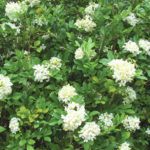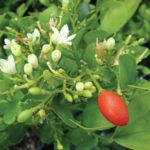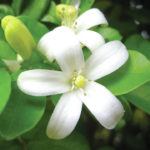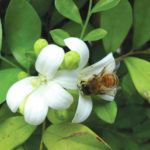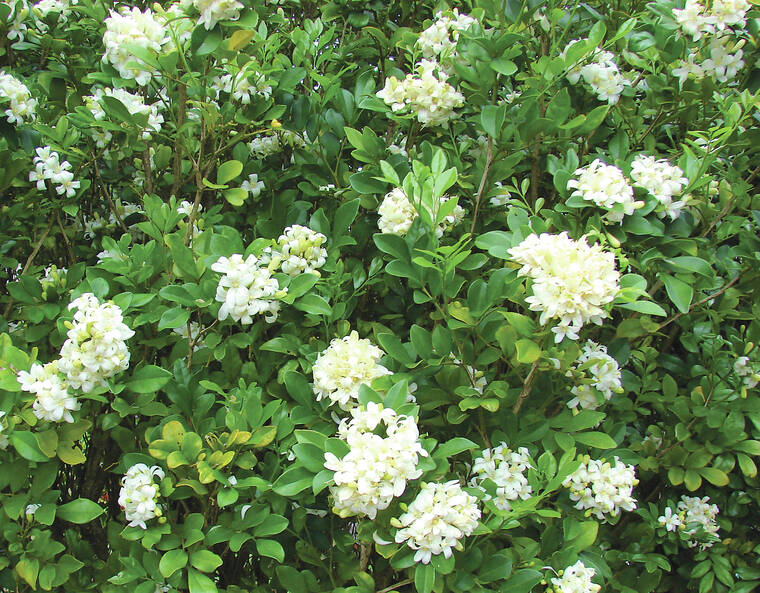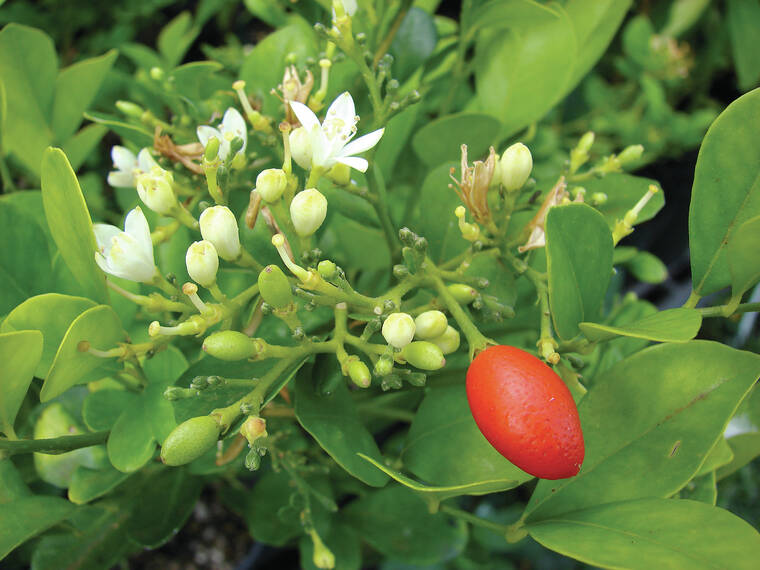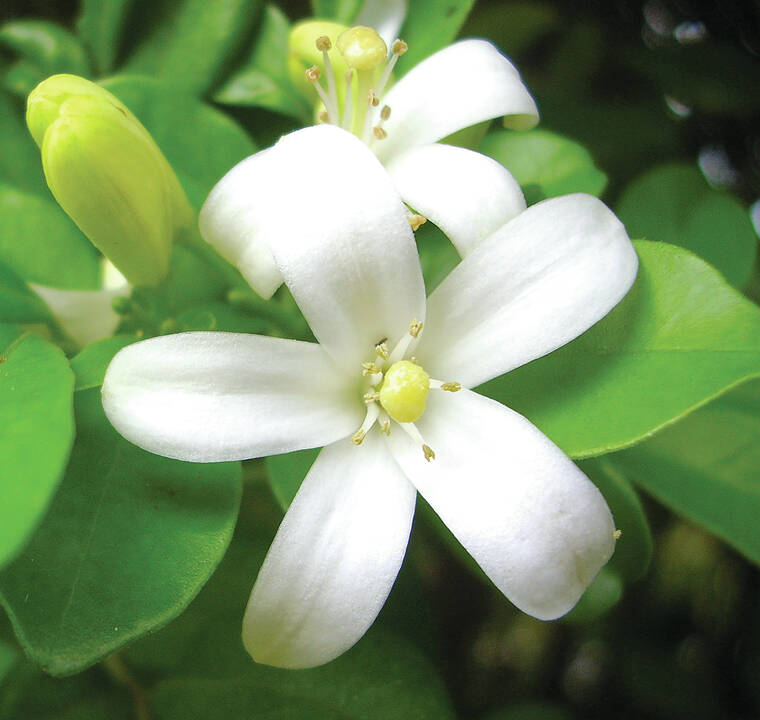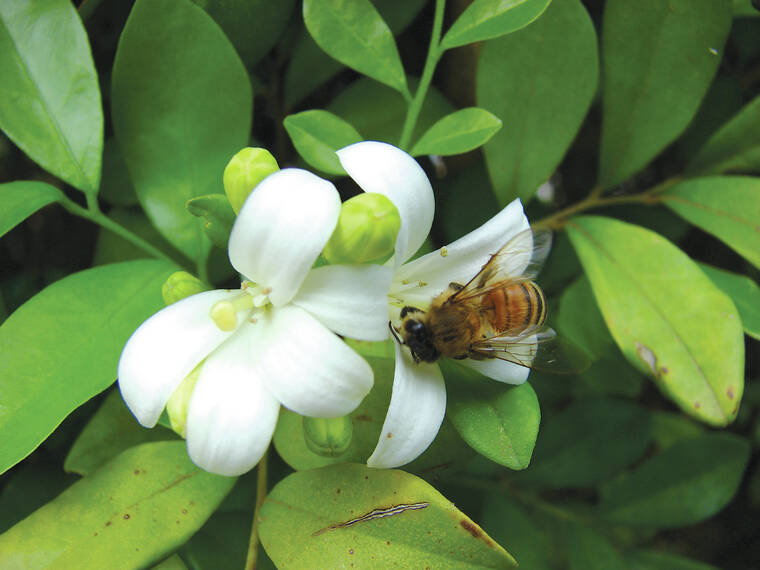For gardeners with limited space, a hearty shrub or small tree that produces fragrant blossoms nearly year-round might be a good choice. Mock orange fills that bill.
A member of the rutaceae (citrus) family, this plant produces flowers throughout the year that are citrus-like in appearance and fragrance. It also produces a small red fruit, but it is not edible.
The plant we know here as mock orange is botanically named Murraya panticulata. It’s closest relative in Hawaii is the curry leaf tree (Murraya koenigil).
The common name mock orange is used, however, in other places for botanically different species with somewhat similar characteristics. To further confuse the issue, M. panticulata sometimes bears the moniker orange jasmine. Additionally, this plant has the Hawaiian name alahe’e haole, probably because both alahe’e and mock orange produce fragrant white flowers.
Though mock orange is native throughout India, Myanmar, Sri Lanka, Southeast Asia and islands in the southwestern Pacific, it is now grown throughout tropical and subtropical regions of the world. Parts of the plant are used medicinally in some locations.
Mock orange wood has several uses, especially where it is native. The form and shape of the plant’s roots make them excellent for small carvings, while the distinctive yellow trunk wood of mature trees can be crafted into attractive walking sticks and other larger items.
The plant was introduced to Hawaii in the 1800s and gained popularity toward the middle of the century, mostly as a hedge plant for screening or blocking the wind. Today, mock orange plants are also used as small specimen trees or shrubs as well as street trees. They can be attractive potted plants and make lovely bonsai specimens.
Several features of the mock orange make it a good choice for your garden. In addition to the attractive clusters of white flowers, it also produces a small red fruit. The heavy orange-flower fragrance of the flowers can enchant us and also attracts pollinating bees to the garden. The red fruit is an added attraction for us and also brings birds to the garden. The glossy green foliage as well as the fragrant flowers are often incorporated into lovely haku- or wili-style lei.
Within each of the fruits of the mock orange are one or two seeds that make propagation of the species rather easy. Though cuttings may also work for reproduction, seeding is usually more successful.
Once the fruit is red and ripe and starts to turn brown, you can squeeze the seeds from the fruit, let them dry a bit and plant them in a seedling mix with good drainage. Propagation from cuttings is a little less reliable but worth a try. Short cuttings from semi woody stems will do best if dipped in a rooting hormone and placed in a damp mix of perlite and vermiculite. To encourage root growth, remove most of the leaves and all of the flowers from the cutting.
New plants will grow well in a sunny or partly shady section of a garden where the soil drains well. In healthy soil, they grow quickly in the first year or two then slow down until they reach about 20 feet. Mock orange is wind tolerant and somewhat drought and salt tolerant once mature, but needs adequate water and some protection during its first year or two.
Once the plants are established, they can be pruned to the desired shape. Removing the lower branches creates a more tree-like growth habit. If you want a hedging shrub, keep all the branches and prune them back regularly to keep the lower branches full of leaves and flowers.
Fertilizing your mock orange several times a year will help it thrive. Though not especially prone to insect or disease attacks, early diagnosis and treatment of problems can help keep your plant healthy. Caring for mock orange plants while surrounded by its wonderful fragrance will encourage you to give her the special attention she deserves.
Mock orange plants appear regularly in nurseries as well as big box stores here in Kona. Watch for them and be sure to check the botanical name of the plant you buy if you want the plant species described here. Once you find it, plant it and enjoy all of the attractive features it will add to your garden.
Diana Duff is a plant adviser, educator and consultant living part time in Kailua-Kona.
Gardening Events
Every Saturday: “Work Day at Amy Greenwell Garden” from 9 a.m. to 12:30 p.m. Meet at the Garden Visitor Center across from the Manago Hotel in Captain Cook. Come with a mask and be prepared to practice social distancing. Volunteers can help with garden maintenance and are invited to bring a brown bag lunch. Water and snacks provided. Call Peter at 323-3318 for more information.
Available now: “Crop Insurance presentation covering CLR” at https://bit.ly/3kbxRGr.
Tuesday: “Q&A panel discussion with crop insurance presenters on ZOOM.” Registration is free but required at www.hawaiicoffeeed.com/coffeeinsur or by calling Matt at (808) 322-0164 at least two days prior to the event. Another Q&A at 10:30 a.m. on Dec. 2.
Friday and Saturday: Hawaii Tropical Fruit Growers Conference on “Mango Makers and Food Preservers” at the Maui County Business Resource Center. In-person events canceled but new videos will be uploaded at www.htfg.org. Mini-sessions and tours Oct. 10-14 on Molokai, Oahu, Kauai, and in Hilo and Kona. More information, registration forms and fee schedule are available at www.htfg.org or by contacting Ken Love at kenlove@hawaiiantel.net or Mark Suiso at mark.suiso@gmail.com.
Farmer Direct Markets (check websites for the latest hours and online markets)
Wednesday: “Ho‘oulu Farmers Market” at Sheraton Kona Resort &Spa at Keauhou Bay
Saturday: “Keauhou Farmers Market” 8 a.m. to noon at Keauhou Shopping Center
Information on their online market at keauhoufarmersmarket.com/onlinemarket
“Kamuela Farmer’s Market” 7:30 a.m. to noon at Pukalani Stables
“Waimea Homestead Farmers Market” from 7:30 a.m. to noon at the Waimea middle and elementary school playground
Sunday: “Pure Kona Green Market” 9 a.m. to 2 p.m. at Amy Greenwell Garden in Captain Cook
“Hamakua Harvest” 9 a.m. to 2 p.m. at Highway 19 and Mamane Street in Honoka‘a
Plant Advice Lines
Anytime: konamg@ctahr.hawaii.edu; Tuesdays and Thursdays from 9 a.m. to noon at UH-CES in Kainaliu at (808) 322-4893.
